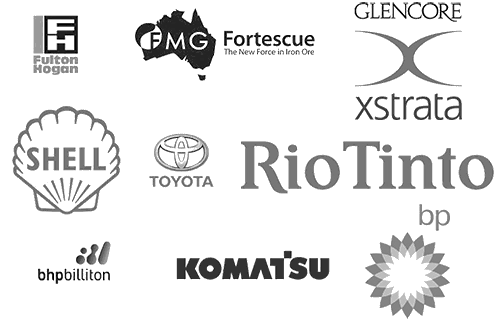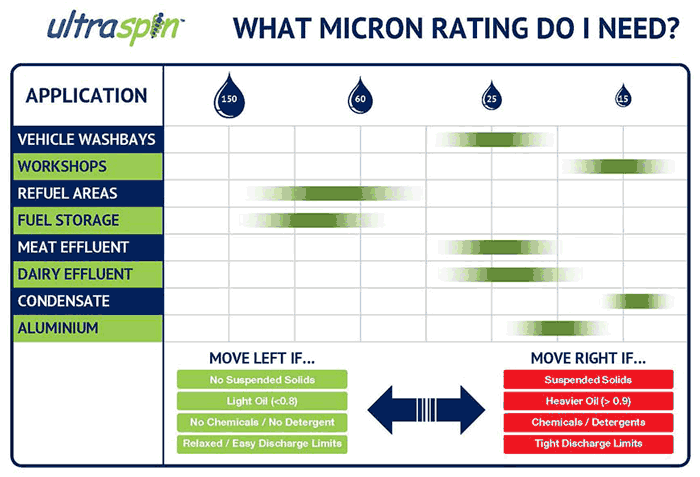Oil Water Information
Completing the learning curve on oily water separator technology
Oil Separator Selection – made simple
There are more than 15 different oil separation technologies that can be used to treat oily water. Within each technology type there are small design differences between vendors which can get confusing! This page has been put together so that you can better appreciate important design factors and how they affect each oil separator type. The information is in the form of a series of ‘tutorials’. We hope you find them helpful and interesting. Make sure you let us know what you think.
Tutorial 1: Four Types of Oil Pollution in Water
- Free Oil:
- Free floating and often on the surface
- Large oil droplets typically more than 150 micron.
- Can be removed via gravity given enough time
- Easy to remove – lots of treatment options
- The subject of European EN-858-1 ‘5 mg/l ‘ oil water test test standard
- Emulsified Oil:
- Oil droplets between 2 and 150 micron in size
- Dispersed throughout the water
- Require a powerful oil water separator to remove smaller oil droplets
- Includes oil with small solids particles attached
- The subject of more comprehensive USA oil water test standard
- Dissolved Oil:
- Oil droplets less than 2 microns
- Cannot be seen to the naked eye, in fact the water may appear to be ‘clean’
- Includes detergents and cleaners dissolved in the water
- Soluble hydrocarbons like benzene and toluene
- Biological degradation of ‘insoluble’ oil like diesel cause dissolved oils
- Cannot be removed with gravity or plate packs; in fact they may make the problem worse!
- Can be over 2000 mg/l oil and grease
- Heavy Oil:
- Oil with a density greater than 1000 kg/m3 (e.g. Bunker ‘C’ fuel oil)
- Oil that sticks to heavy solids
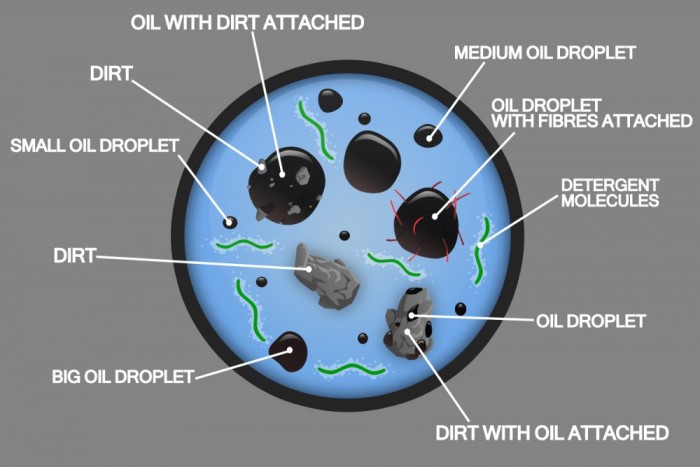
Not sure which of the 4 types of oil contamination you have? Let us help
Give us a call or send an email. Using our extensive data base of customers oil water pollution types we can put you in the picture in no time!
In addition take advantage of our extensive oily water test facilities and laboratory. We are are able to analyse and characterise your oily water problem and give you a full report. In many cases we can do this for free!
Tutorial 2: Oil Droplet Size
Why is Oil Droplet Size so important?
All oily water separators are designed to treat a particular range of micron size of oil droplets – this is called the micron rating of the separator – or micron separator range. Some oil separators wont be able to treat oil droplets that are small (eg Gravity, Coalescing Plate Packs, VGS, European EN-858 Tanks) and some oil water interceptors are not able to treat large oil droplets (e.g. Media filters, DAF and Chemical Treatment systems).
A 150 micron rated separator will separate oil droplets 150 micron and larger, but not separate 25 micron droplets – those oil droplets will still be in the water and get discharged with your “treated” water.
A 25 micron rated separator is more powerful and will separate 25 micron droplets as well as larger oil droplets
This is why oil droplet size, and oil droplet size distribution, is one of the most important factors in determining the oil water separation performance of all mechanical separators. Oil droplets in water are never one size, but present in a size distribution, with some smaller and some larger. For the more technical inclined we find in most applications the oil droplet size distribution is a log / normal shape distribution.
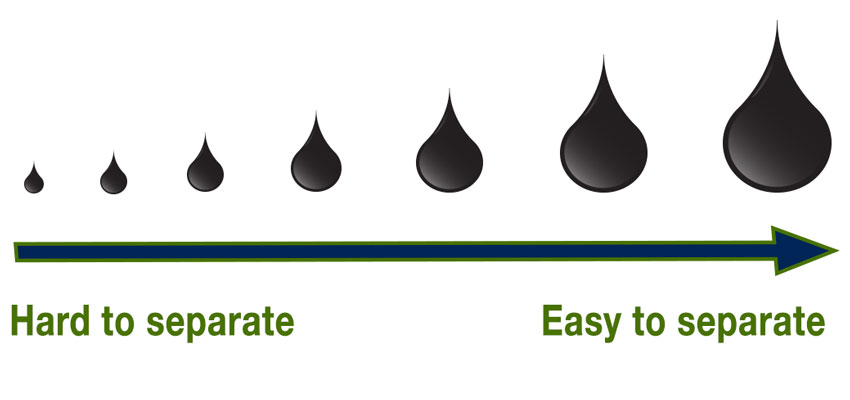
Measuring Oil droplet size
Oil droplet size and the oil droplet size distributions must be measured on site with ‘live’ flowing water. You cannot sample your water and send it to a laboratory because the oil droplet size with change very quickly after sampling and the results from the laboratory will be meaningless.
Oil droplet size can be measured on site by a skilled technician with the required equipment. Its is not difficult when you know how but it is a highly specialised area of water analysis; so don’t expect a ‘normal’ laboratory to have the required expertise or equipment. We have many years experience and have the expertise and calibrated equipment, so if you need help let us know.
It is vital to have both an accurate oil droplet measuring tool capable of telling the difference between oil droplets, air bubbles and suspended solids AND a skilled operator experienced in oily water analysis. Ultraspin has the best of both! So if you would like our help please let us know. There is no more guesswork required.
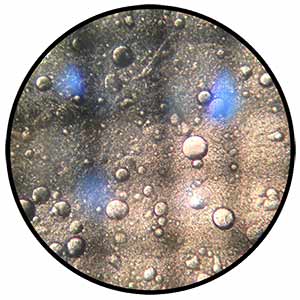
Estimating Oil Droplet Size: Similar Applications
There are a couple of ways to estimate your oil droplet size. They are not as accurate as direct measurement described above but should give you a rough idea.
The Ultraspin table below can give you a guide based on “typical” oily water situations. The presence of suspended solids, additives, detergents or surfactants will change your droplet size to be larger or smaller, so you should account for this if they’re in your water.
Estimating Oil Droplet Size: Visually Compare Water Samples
You can also get a rough idea of your oil droplet size with a visual inspection of your sample. In general, if you can see the droplets with the naked eye, they are large, say 150 micron plus. If the water looks hazy, white or milky, the droplets are very small (less than 25 microns, often less than 10 micron). We have a data base of sample photos from thousands of applications with matching droplet sizes to give you a visual guide. Look for a sample that has similar characteristics to yours. If you need help, email us a photo of your sample and our oily water engineers will help you.
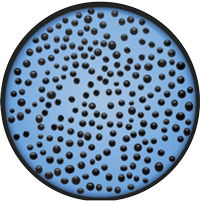 |
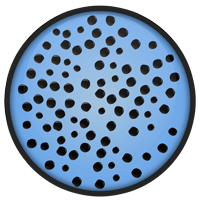 |
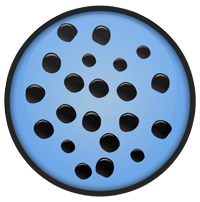 |
 |
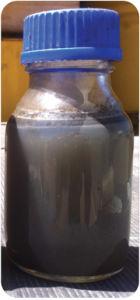 |
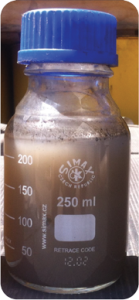 |
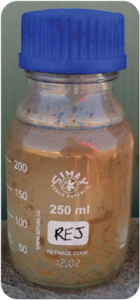 |
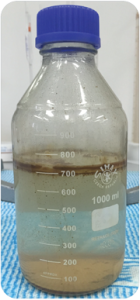 |
Tutorial 3: Comparing Oil Water Separators
Now that you understand the 4 types of oil contamination – and the importance of oil droplet size – you can begin to appreciate how different types of oil separator will work under different oily water feed conditions.
For example all types of oil water separators are rated to treat a particular range of oil droplet sizes. You can narrow down your choice of oil separator technologies that suit your application based on what droplet size each separator technology is designed to treat.
| Separator Technology Type | 300 micron | 150 micron | 60 micron | 25 micron | 15 micron |
|---|---|---|---|---|---|
| Ultraspin Separators | |||||
| Membranes | |||||
| Centrifuges | |||||
| Media filters | |||||
| Gas flotation with chemicals | |||||
| Gas flotation without chemicals | |||||
| Coalescing Plate Packs - VGS | |||||
| API gravity separator | |||||
| European tanks / SPEL | |||||
| Basic tanks, double or triple interceptors |
Oil Water Separator Performance Curves
Oil Separator Efficiency (%) = 100 x ( Cin – Cout/ Cin)
- Cin = feed inlet concentration (mg/l)
- Cout = discharge outlet concentration (mg/l)
More powerful separators have a number of advantages including obtaining better quality discharge water, meet or exceed Local and National Trade Waste discharge standards, meet or exceed future discharge standards, deal with accidental oil spills, tolerate higher strength non-“quick-break” detergents and cleaners.
Oil Water separation efficiency can be objectively accessed by examining the separator oil droplet size vs. separation efficiency curves. For higher quality separators these curves should be readily available from manufacturers. Manufacturers should also be able to confirm performance to these curves by independent testing. The purpose of oily water separators is to obtain clean water. However, claims of a separator being able to achieve less than 10 mg/l discharge are meaningless and deceptive without recourse to oil droplet size performance curves.
It’s like a pressure vessel manufacturer not being able to measure pressure, or an oven manufacturer not being able to measure temperature. It’s ridiculous – but it happens!
Always ask your supplier for an objective oil droplet based performance curve like the one shown here. Make sure its one they have generated by measuring oil droplet size on their equipment, and not copied from another vendor like Ultraspin. Compare the curve to the oil droplet size you have or need. If a supplier can’t or won’t send you their own performance curve – be very wary!
Tutorial 4: Other Oily Water Fluid properties
Temperature
The viscosity of the water falls as the water temperature rises. This allows oil droplets to move more easily through the water phase, thereby producing better oil separation with many oil water separators (but not all). Therefore, increased temperature improves separation efficiency for most oily water separators. The Ultraspin separator can be supplied to operate within the temperature range 0 to 120°C (32 to 248°F), at higher temperatures special materials may be required.
Oil Water Separators that work better at higher temperatures include:
- Coalescing plate packs (5 to 80 oC)
- Ultraspin Separators (5 to 120 oC)
- Gravity tanks and vessels (5 to 90 oC)
- Centrifuges (5 to 90 oC)
Oil water separators that may not separate as effectively at higher temperatures include:
- Air flotation devices (DAF, CAL, IGF) (5 to 30 oC)
- Media filters (5 to 45 oC)
- Membranes (5 to 65 oC)
- These types of separator may require water coolers to work effectively.

For many oil water separators the oil removal efficiency is dependent on the difference in density between the contaminant and the water. The separation efficiency increases as the difference in density increases. The density difference can increase if you have lighter oils or your water is salty, or both. Typical densities for Oil are 950 to 750 kg/m3 (0.034 to 0.027 lb/in3) and water : 1050 to 995 kg/m3.(0.038 to 0.036 lb/in3).
For these types of oily water separator performance improves as the density difference increases, and generally the density difference must generally be more than 25 kg/m3
- Coalescing plate packs
- Gravity tanks / SPEL / Triple and double interceptors
- Ultraspin Separators
For these types of oil water separators are not greatly effected by small density differences (say less than 25 kg/m3):
- Media filters
- Membranes
- Air flotation (DAF, IAF, CAF)
Inlet Concentration
Some types of oil water separator are NOT well suited to high oil feed concentrations and high feed oil concentrations overload or block the systems. For these types of system careful pre-treatment to remove oil will be required.
- Coalescing plate packs (max 1% oil or 10,000 mg/l).
- With high oil concentration for this type of separator the plates become coated in oil and sludge. This requires the plates to be removed and cleaning to restore oil removal efficiency.
- Air flotation systems (DAF, IAF, CAF) (max 1% oil or 10,000 mg/l)
- Media filters (typical max 100 mg/l oil )
- Membranes (typical max 300 mg/l)
Other types of system can accommodate 100% oil concentration for a period of time:
- Ultraspin systems
- Centrifuges
- Gravity tanks / SPEL / Triple and double interceptors
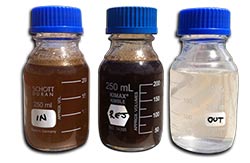
Tutorial 5: Separator Design
Coalescing Plate Packs
Also known as, Tilted Plate Interceptors (TPI), Corrugated plate packs (CPP and CPS), Vertical gravity separators (VGS) and similar. Some important design factors include:
- Wetted Plate area: Lower cost but don’t work as well.
- Mean Plate spacing: Closely packed plates (about 10mm) work better but are prone to blockages.
- Oil type – some are simply not collected
- Shape of plates. Complex shapes may be very difficult to clean.
- Plate material. Some materials are low cost but will warp and degrade in the sun or when exposed to hydrocarbons.
Gravity Settling Tanks
Simply allowing oil to float to a surface via gravity is a simple way to remove easily separable oil droplets that are about 150 microns or more. Examples of this technology include API separators, triple Interceptors, above-ground tanks or collection pits.
Some important design factors include:
- Project plan area of settling tank.
- Inlet design.
- Exit design.
- Aspect ratio.
- Oil removal / skimmer design.
Ultraspin Separators
Ultraspin engineers were the designers of the world’s first commercially successful oil removal hydrocyclones. One of the keys to our successful designs is the use of optimum geometric ratios, such as separator length, diameter, orifice sizes and taper angles to achieve maximum separation. By comparison with conventional solids removal hydrocyclones, our designs are very long and generate high centrifugal separation forces.
Some important design factors include:
- Hydrocyclone nominal size: Larger hydrocyclones are lower cost but don’t work as well.
- Reject orifice size.
- Hydrocyclone geometry.
- Separator Swirl Number: Higher swirls can increase efficiency but may emulsify the oil.
Tutorial 6: Method of Operation
Maintenance
Many oily water separators, such as the plate pack type, require regular cleaning and maintenance to continue functioning. It is important for customers to fully understand what is involved to keep these technologies operating before committing to a purchase.
Typical Cleaning periods:
- Plate packs:Typically need cleaning every month ( also known as Corrugated Plate Separators (CPS), Vertical Gravity Separators (VGS), Tilted Plate Interceptors (TPI))
- API and Gravity Pits: Twice a year for De-sludge and cleaning
- Ultraspin Separators: Typically every 4 to 6 months
To accurately determine the real cleaning and maintenance requirements for oily water separators:
- Read the full installation and operating manuals from the vendors. They can sometimes be downloaded from the internet.
- Speak to actual users of the equipment.
- Contact local government regulators.
- Note: Some plate packs contain only a 20L oil drum. This often fills and overflows, creating a mess and non- compliance with discharge. Ultraspin supplies a 500L oil drum as a minimum to avoid these problems.
Flow rate
For most conventional oily water separators, like plate packs, the separation efficiency reduces as the flow increases.
But for the Ultraspin system it is the opposite! Increased flow increases the strength of the centrifugal forces, increasing the oil separation force.
Reject Ratio
The ‘reject ratio’ is the ratio of the oily reject stream leaving the Ultraspin separator to the inlet of feed flow rate of fluid to the separator. This is an important parameter in the operation of the separator. Typical reject ratios are from 1 to 20% subject to design requirements.
A minimum reject ratio exists for separator efficiency – below that and it will be impaired. It depends on the size of the reject orifice. A high reject ratio does not affect the performance of the separator, but leads to excess water in the separated oil reject and can result in unnecessary re circulation of the water. Hence, the optimum reject ratio is just above the minimum reject ratio. The reject ratio is usually set by Ultraspin design engineers and should not require any further adjustment by clients.
Underflow Recycle
A proven method of increasing the power of separation of the Ultraspin separator is to recycle part or all of the treated underflow back to the inlet for further treatment. This is a feature unique to Ultraspin separators. In this way very small oil droplets that missed being separated in the first pass have a second chance at being recovered in the second pass. This can greatly improve separation efficiency with emulsified oily water mixtures.
This can be illustrated by an example:
- One pass (no recycle): 85% of 20-micron droplets will be removed.
- Two passes (or 50% underflow recycle): 98% of 20-micron droplets will be removed.
Separator Configuration
There are many methods to configure a system including:
- batch treatment mode
- continuous operation
- demand activation.
